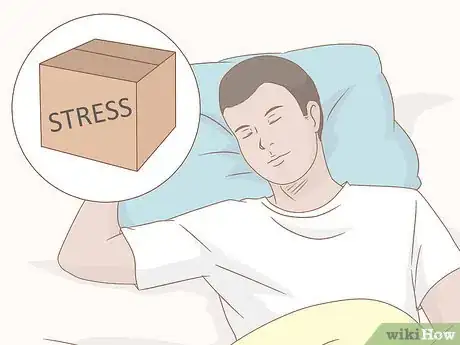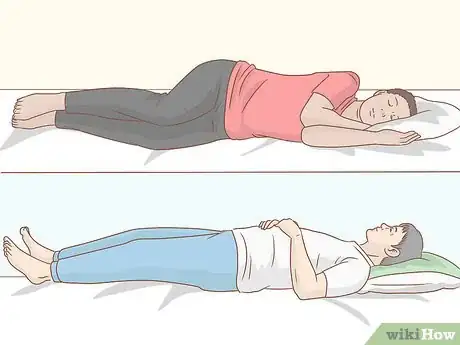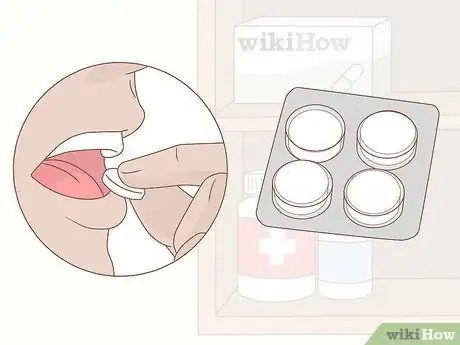This article was medically reviewed by Luba Lee, FNP-BC, MS. Luba Lee, FNP-BC is a Board-Certified Family Nurse Practitioner (FNP) and educator in Tennessee with over a decade of clinical experience. Luba has certifications in Pediatric Advanced Life Support (PALS), Emergency Medicine, Advanced Cardiac Life Support (ACLS), Team Building, and Critical Care Nursing. She received her Master of Science in Nursing (MSN) from the University of Tennessee in 2006.
There are 18 references cited in this article, which can be found at the bottom of the page.
This article has been viewed 37,888 times.
We all know that good sleep is critical for a person’s well-being. If you cannot sleep well, the trick may be to explore your own sleep preferences and to tailor your environment and behaviors accordingly. Investing the time now can lead to substantial health benefits (and better dreams!) in the long term.
Steps
Developing a Sleep Routine
-
1Keep a consistent bedtime. Try to go to bed at the same time every night and wake up at the same time every morning. You may also want to change your regular bedtime to ensure that you are getting enough sleep.[1]
- For example, if you usually don’t go to bed until 11:30pm and you wake up at 6:00am, then you may want to consider pushing back your bedtime to 10:30pm to get more sleep.
-
2Practice patience. If you try to go to sleep at a set time and your body resists, don’t give in completely. Stay up (still lying in bed) for an extra 15 minutes and then attempt to fall asleep again. Resist the urge to get angry or frustrated as this will only increase stress and keep you up longer.[2]
- Use the extra minutes to think of 15 dreams that you would like to have.
-
3Avoid things that might keep you up or disturb your sleep. There are some things that might be interfering with your ability to fall asleep and stay asleep at night. Consider what you can change to improve your sleep, such as by avoiding:[3]
- Drinking alcohol at night.
- Using stimulants such as caffeine and nicotine in the afternoon and evening.
- Eating heavy meals before bed.
- Exercising within four hours of your bedtime.
- Napping during the day.
-
4Slow your mind. Avoid dwelling on the day’s duties, stress, tension, and negative emotions. Mentally visualize putting all of your concerns in a box and placing that box on a shelf to take down tomorrow.[4]
- Your mind continues to work on developing skills during sleep via a process called “consolidation.”
-
5Power down gadgets. An hour before bedtime, turn off the TV and put your phone away. Instead of watching the news, read something light-in-content. A good novel or comic is a great way to escape reality and segue into dreams.[5]
-
6Relax your body. The mind and body are two pieces of a whole. If your mind is relaxed, you need to get your body to that state as well. About 30 to 45 minutes before bed, avoid all strenuous physical activities, essentially anything that breaks a sweat.[6]
- Try doing a relaxing yoga routine. Yoga-inspired stretches can help you to improve overall circulation and fall into a deep sleep. Start by taking calming, deep breaths, in through the nose and out the mouth. Then, sit cross-legged on the ground for a seated cross-bend, for example. Or, simply bend over and slowly touch your toes.[7]
-
7Harness the power of scent. Light a few candles prior to bed (just remember to snuff them out), use incense, or massage your hands with essential oils. Lavender and vanilla are particularly relaxing scents.
-
8Outfit yourself properly. As you choose your nightclothes, take into account personal preferences, but also factors such as temperature and skin irritants. For example, if polyester feels itchy, you might be better served by choosing cotton fabric. Flannel is a popular fabric for sleep clothes as well, but many find it to be too hot in the summer.[8]
- Investigate the benefits of sleeping naked. Wearing no clothes lowers your body temperature leading to deeper, more restful sleep. It could also help build body confidence.
Creating a Comfortable Environment
-
1Use your bed only for sleeping and sex. To make sure that your mind knows that it is supposed to relax and sleep when you get into bed, it is important to make sure that you only do sleep activities in your room. Do not read, eat, work or watch television in bed.[9]
- Also, make sure that you go to bed only when you are sleepy.
-
2Think about lighting. Install dimmable lights or use a bedside lamp. Try to avoid going immediately from full light to full dark, ease your body into a state of sleep.[10]
- Make sure that your room is dark and that there are no lights coming into the room that might disturb your sleep. You might consider getting some light blocking curtains if your room tends to get really bright before you have to wake up or if street light shine in. Or, you could wear a sleep mask.
- If you need a little light to feel comfortable, consider a nightlight, some flameless candles, or even a lit up alarm clock.
-
3Choose a temperature preference. Start out by picking one temperature and then gauging how your body reacts overnight. The ideal thermostat setting is around 65 degrees for deep sleep. Avoid extreme hot or cold temperatures in your bedroom.[11]
- The most important thing is to keep your head cool throughout the night without chilling the rest of your body. This often means that you will want to experiment with clothing and linen layering.
-
4Keep it clean. Allergens are a serious problem for many people and complications (sneezing, wheezing) often appear at night. Eliminate dust in your bedroom regularly to keep it from going airborne. A good air purifier can help with this as well.[12]
- In winter, humidifiers can assist people with breathing problems by adding moisture to the air.
-
5Use your nightstand. Stock it with all of the items that you will need throughout the night. Place medications, tissues, lotion, any electronic devices/alarms within arm’s reach.
-
6Plan ahead for noises. If you wake easily, consider purchasing ear plugs or muffs intended for sleep.[13] Sound machines are also a good investment. They can mimic soothing waves, rain, or even jungle sounds!
- You can also try playing some white noise, such as rain or ocean sounds on your phone. Just make sure that the light from your phone is blocked out.
-
7Purchase an excellent mattress. One might use a (Goldilocks) firm mattress, not too hard and not too soft. One might consider a thick cotton Futon style mattress without springs, on some stiff surface like a bed-spring, plywood or some stand that may come with it.[14]
- Mattresses impact blood flow and, therefore, those that relieve pressure points are the best for overall health.
-
8Find the proper pillow(s). There are pillows for your head and for your body, and those made with foam, feathers, and even water. The pillow that you choose will often depend on your preferred sleeping position. For example, back-sleepers often place an extra pillow under their stomach.[15]
- Pregnancy pillows, in particular, are often used by women to cradle their abdomen and relieve hip pain.
Making Physical Changes
-
1Exercise strategically. Breaking a sweat creates extra stores of energy, but it also has the potential to stimulate deeper sleep. Individuals suffering from sleep disorders, in particular, stand to see benefits from long-term workout patterns.[16]
- The key is consistency. Commit yourself to three 30-minute work-out sessions a week and build up from there.
- Insomnia increases with age.[17] Counteract this by participating in aerobic activity. Join a cycling class at the local gym or begin a DVD kickboxing routine in the privacy of your own home.
- Healthy sleep also promotes workout recovery via accelerated protein synthesis and muscle growth.
-
2Experiment with various sleep positions. Your choices here are: side, back, and stomach. Side-sleeping is the most common with 41% of people preferring some version of the fetus position (side lying with knees slightly bent). Sleeping this way especially benefits anyone suffering from hip issues, including pregnant women.[18]
- Is it better to sleep on the left or right? You may experience more episodes of reflux with right-side sleeping.
- Sleeping on your back is better with a pillow placed under your knees for lumbar support.
- Physicians are the most concerned about stomach sleepers as this position places pressure strain on the lower back and neck.[19]
-
3Start a food and sleep journal. Write down everything that you eat or drink, along with the time, and how it affected your sleep. Then, you can look back to see any food-related patterns. For example, do you sleep better after drinking a glass of milk in the evening?
- You may also find that the more you sleep, the less you eat. A sleep-deprived body produces less of the hormone leptin, which tells your body to stop eating, thus leading to overeating and possible obesity.
-
4Eat for sleep. Altering your diet in a positive way can lead to significant improvements in your waistline via the process of deeper sleep and hormonal balance.[20]
- Avoid alcohol and caffeine. These are the biggest offenders.
- Examine the timing of meals. Be consistent with your meals both in substance and scheduling. Don’t skip meals early in the day or you could create a hormonal imbalance later, contributing to poor sleep.
- The digestion of food affects the body as it enters the bloodstream. Ideally, you want to finish your evening meal two to three hours before going to sleep. This allows your body enough time to process the food.
-
5Hydrate for sleep. Drinking water is your safest bet to ensure a good night’s sleep. Caffeine and sugar act as stimulants and should be consumed in limited quantities.
-
6Explore herbal remedies. Try various kinds of herbal teas and drinks such as milk and honey, usually warmed.
- Chamomile tea is a favorite herbal beverage. It is best to drink a cup one to two hours before bedtime.[21]
-
7Consider medical options. Various pharmaceuticals are available to improve sleep quality. However, be sure to understand any possible side effects. It is advisable to consult with your doctor when considering the use of medical sleep aids.[22]
Tips and Warnings
- Various serious health disorders can result in poor sleep. If you are unable to get consistent shut-eye, one of the following may be to blame: parasomnias (including night terrors), narcolepsy, or restless leg disorder, among other conditions. If you believe this may be your situation, contact your personal doctor or consult with a sleep clinic.[23]
- Sleeping in the same bed with others can also affect your sleep. A restless partner may disturb you every time they toss, turn, snore, or whatever. You will need to get your sleep partner on the same schedule as you, if possible. If not, you may have to consider sleeping in separate rooms.
References
- ↑ https://www.helpguide.org/articles/sleep/getting-better-sleep.htm
- ↑ https://health.clevelandclinic.org/5-strategies-that-will-help-you-get-back-to-sleep/
- ↑ http://www.helpguide.org/articles/sleep/how-to-sleep-better.htm
- ↑ https://www.helpguide.org/articles/sleep/getting-better-sleep.htm
- ↑ https://www.helpguide.org/articles/sleep/getting-better-sleep.htm
- ↑ https://www.hopkinsmedicine.org/health/wellness-and-prevention/sleepless-nights-try-stress-relief-techniques
- ↑ https://my.clevelandclinic.org/health/articles/8133-stress-10-ways-to-ease-stress
- ↑ https://www.sleep.org/sleep-hygiene/what-to-wear-to-bed/
- ↑ https://www.helpguide.org/articles/sleep/getting-better-sleep.htm
- ↑ https://www.cdc.gov/niosh/emres/longhourstraining/light.html
- ↑ https://health.clevelandclinic.org/what-is-the-ideal-sleeping-temperature-for-my-bedroom/
- ↑ https://www.sleepfoundation.org/allergies-and-sleep
- ↑ http://healthysleep.med.harvard.edu/healthy/getting/overcoming/tips
- ↑ http://healthysleep.med.harvard.edu/healthy/getting/overcoming/tips
- ↑ https://health.clevelandclinic.org/is-your-pillow-hurting-your-neck-7-tips-for-better-sleep/
- ↑ https://www.helpguide.org/articles/sleep/getting-better-sleep.htm
- ↑ https://my.clevelandclinic.org/health/diseases/12119-insomnia
- ↑ https://www.hopkinsmedicine.org/health/wellness-and-prevention/choosing-the-best-sleep-position
- ↑ https://health.clevelandclinic.org/back-side-stomach-sleep-position-best/
- ↑ https://www.hopkinsmedicine.org/health/wellness-and-prevention/better-sleep-3-simple-diet-tweaks
- ↑ https://www.ncbi.nlm.nih.gov/pmc/articles/PMC2995283/
- ↑ https://www.helpguide.org/articles/sleep/sleeping-pills-and-natural-sleep-aids.htm
- ↑ https://www.betterhealth.vic.gov.au/health/conditionsandtreatments/sleep










































